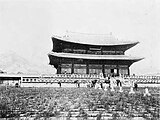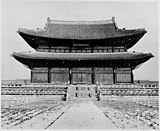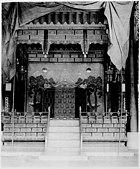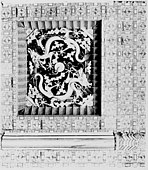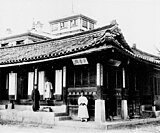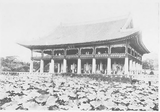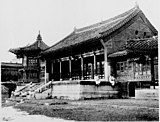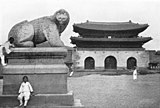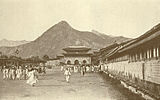Gyeongbokgung
| Gyeongbokgung | |
|---|---|
경복궁 | |
 The palace, with the mountain Bugaksan overlooking it (2008) | |
 | |
| General information | |
| Type | Royal palace (former) |
| Architectural style | Korean |
| Town or city | Jongno District, Seoul |
| Country | South Korea |
| Coordinates | 37°34′43″N 126°58′38″E / 37.57861°N 126.97722°E |
| Current tenants | National Palace Museum of Korea National Folk Museum of Korea |
| Opened | 1395 |
| Technical details | |
| Floor area | 415,800 square metres (4,476,000 sq ft) |
| Website | |
| www | |
| Korean name | |
| Hangul | 경복궁 |
| Hanja | 景福宮 |
| Revised Romanization | Gyeongbokgung |
| McCune–Reischauer | Kyŏngbokkung |
Gyeongbokgung (Korean: 경복궁; Hanja: 景福宮; lit. Blessing Scenery Palace), also known as Gyeongbokgung Palace, was the main royal palace of the Joseon dynasty. Built in 1395, it is located in northern Seoul, South Korea. The largest of the Five Grand Palaces built by the Joseon dynasty, Gyeongbokgung served as the home of the royal family and the seat of government.
Gyeongbokgung continued to serve as the main palace of the Joseon dynasty until the premises were destroyed by fire during the Imjin War (1592–1598) and abandoned for two centuries. However, in the 19th century, all of the palace's 7,700 rooms were restored under the leadership of Prince Regent Heungseon during the reign of King Gojong. Some 500 buildings were restored on a site of over 40 hectares.[1][2] The architectural principles of ancient Korea were incorporated into the tradition and appearance of the Joseon royal court.
In the early 20th century, much of the palace was systematically destroyed by Imperial Japan during its occupation of Korea.[3] On January 21, 1963, it was designated as a cultural property.[4] Since the 1990s, the walled palace complex is gradually being restored to its original form. It also houses the National Palace Museum and the National Folk Museum within the premises of the complex.
Overview
[edit]Gyeongbokgung, located in north of Gwanghwamun Square, was built three years after the Joseon dynasty was founded and it served as its main palace.[5] With the mountain Bugaksan behind it and the Street of Six Ministries (today's Sejongno) outside Gwanghwamun Gate, the main entrance to the palace, Gyeongbokgung was situated in the heart of the Korean capital city. It was steadily expanded before being reduced to ashes during the Japanese invasion of 1592.
For the next 273 years the palace grounds were left derelict until being rebuilt in 1867 under the leadership of Regent Heungseon Daewongun. The restoration was completed on a grand scale, with 330 buildings crowded together in a labyrinthine configuration. Within the palace walls were the Outer Court (oejeon), offices for the king and state officials, and the Inner Court (naejeon), which included living quarters for the royal family as well as gardens for leisure. Within its extensive precincts were other palaces, large and small, including Junggung (the Queen's residence) and Donggung (the Crown Prince's residence).
Due to its status as the symbol of national sovereignty, Gyeongbokgung was extensively damaged during the Japanese occupation of the early 20th century. In 1911, ownership of land at the palace was transferred to the Japanese Governor-General. In 1915, on the pretext of holding an exhibition, more than 90% of the buildings were torn down. Following the exhibition, the Japanese leveled whatever still remained and built their colonial headquarters, the Government-General Building (1916–26), on the site. Only a handful of iconic structures survived, including the Throne Hall and Gyeonghoeru Pavilion.
Restoration efforts have been ongoing since 1990. The Government-General Building was removed in 1996 and Heungnyemun Gate (2001) and Gwanghwamun Gate (2006–2010) were reconstructed in their original locations and forms. Reconstructions of the Inner Court and Crown Prince's residence have also been completed.
The current total area is 415,800 square metres (4,476,000 sq ft).[6]
History
[edit]14th–16th centuries
[edit]
Gyeongbokgung was originally constructed in 1394 by King Taejo, the first king and the founder of the Joseon dynasty, and its name was conceived by an influential government minister named Jeong Do-jeon. Afterwards, the palace was continuously expanded during the reign of King Taejong and King Sejong the Great. It was severely damaged by fire in 1553, and its costly restoration, ordered by King Myeongjong, was completed in the following year.
However, four decades later, Gyeongbokgung was burnt to the ground during the Japanese invasions of Korea of 1592–1598 when Koreans angry at the court of King Seonjo for evacuating Seoul torched the royal residence.[7] The royal court was moved to the Changdeokgung Palace. Gyeongbokgung site was left in ruins for the next three centuries.[8]
19th century
[edit]In 1867, during the regency of Daewongun, the palace buildings were reconstructed and formed a massive complex with 330 buildings and 5,792 rooms. Standing on 4,657,576 square feet (432,703 square meters) of land, Gyeongbokgung again became an iconic symbol for both the Korean nation and the Korean royal family. In 1894, the Japanese occupied the palace and forced Gojong to establish a pro-Japanese government. In 1895, after the assassination of Empress Myeongseong by Japanese agents, her husband, Emperor Gojong, left the palace. The Imperial Family never returned to Gyeongbokgung.[9]
20th–21st centuries
[edit]

In 1915, it was used as the site for the Joseon Industrial Exhibition with new exhibition buildings being erected in the grounds.[10][11]
Starting from 1911, the colonial government of the Empire of Japan systemically demolished all but 10 buildings during the Japanese occupation of Korea and hosted numerous exhibitions in Gyeongbokgung, ongoing demotion was opposed by Yanagi Sōetsu. In 1926, the government constructed the massive Japanese General Government Building in front of the throne hall, Geunjeongjeon, in order to eradicate the symbol and heritage of the Joseon dynasty. Gwanghwamun Gate, the main and south gate of Gyeongbokgung, was relocated by the Japanese to the east of the palace. A further exhibition, the Chosun Exhibition, followed in 1929.[12]
The palace faced further damage when the wooden structure of the relocated Gwanghwamun Gate was completely destroyed amid the devastation of the Korean War.
Gyeongbokgung's original 19th-century palace buildings that survived both the Japanese rule of Colonial Korea and the Korean War include:
- Geunjeongjeon (the Imperial Throne Hall) — National Treasure No. 223.
- Gyeonghoeru Pavilion — National Treasure No. 224.
- Hyangwonjeong Pavilion; Jagyeongjeon Hall; Jibokjae Hall; Sajeongjeon Hall; and Sujeongjeon Hall.
Modern archaeological surveys have brought 330 building foundations to light.
Restoration
[edit]
In 1989, the South Korean government started a 40-year initiative to rebuild the hundreds of structures that were destroyed by the colonial government of the Empire of Japan, during the period of occupied Colonial Korea (1910–1945).
In 1995, the Japanese General Government Building, after many controversial debates about its fate, was demolished in order to reconstruct Heungnyemun Gate and its cloisters. The National Museum of Korea, then located on the palace grounds, were moved to temporary accommodations in December 1996, before being relocated to a new building in Yongsan District in 2005.
By the end of 2009, it was estimated that approximately 40 percent of the structures that were standing before the Japanese occupation of Korea were restored or reconstructed.[13] As a part of phase 5 of the Gyeongbokgung restoration initiative, Gwanghwamun, the main gate to the palace, was restored to its original design. Another 20-year restoration project is planned by the South Korean government to restore Gyeongbokgung to its former status.[14]
Layout
[edit]



Main gates
[edit]- Gwanghwamun (광화문, The Main and South Gate)
- Heungnyemun (흥례문, The Second Inner Gate)
- Geunjeongmun (근정문, The Third Inner Gate)
- Sinmumun (신무문, The North Gate)
- Geonchunmun (건춘문, The East Gate)
- Yeongchumun (영추문, The West Gate)
Oejeon (외전, Outer Court)
[edit]- Geunjeongmun (근정문, The Third Inner Gate)
- Geunjeongjeon (근정전, The Throne Hall)
- Sajeongjeon (사정전, The Executive Office)
- Sujeongjeon (수정전)
- Cheonchujeon (천추전)
- Manchunjeon (만춘전)
Naejeon (내전, Inner Court)
[edit]- Gangnyeongjeon (강녕전, The King's Quarters)
- Gyotaejeon (교태전, The Queen's Quarters)
- Jagyeongjeon (자경전, The Queen Dowager's Quarters)
- Heungbokjeon (흥복전, King Gojong's reception room)
Donggung (동궁, Palace of the Crown Prince)
[edit]- Jaseondang (자선당, The Crown Prince's and Princesses' Quarters)
- Bihyeongak (비현각, The Study of the Crown Prince)
Pavilions
[edit]- Gyeonghoeru (경회루, The Royal Banquet Hall)
- Hyangwonjeong (향원정)
Bridges
[edit]- Yeongjegyo (영제교)
Having passed through the initial main gate (Gwanghwamun Gate, 광화문) and secondary gate (Heungnyemun Gate, 흥례문), visitors would pass over a small bridge named Yeongjegyo (영제교). Located on the top of the canal right next to the bridge were several imaginary creatures known as Seosu.
- Chwihyanggyo (취향교)
Chwihyanggyo was originally located on the north side of the island and was the longest bridge constructed purely of wood during the Joseon Dynasty; however, it was destroyed during the Korean War. The bridge was reconstructed in its present form on the south side of the island in 1953.
Buildings
[edit]Gwanghwamun
[edit]Gwanghwamun (광화문; 光化門) is the main gate of Gyeongbokgung.
Geunjeongjeon
[edit]

Geunjeongjeon (근정전; 勤政殿), also known as Geunjeongjeon Hall, is the throne hall where the king formally granted audiences to his officials, gave declarations of national importance, and greeted foreign envoys and ambassadors during the Joseon period.[15] The building was designated as Korea's National Treasure No. 223 on January 8, 1985. Geunjeongmun (근정문; 勤政門), aligned and located directly to the south of Geunjeongjeon, is the main gate to the courtyard and to Geunjeongjeon. The gate is divided into three separate aisles, and only the king was allowed to walk through the center.
Geunjeongjeon was originally constructed in 1395 during the reign of King Taejo, but was burned down in 1592 when the Japanese invaded Korea. The present building was built in 1867 when Gyeongbokgung was being reconstructed. The name Geunjeongjeon, created by the minister Jeong Do-jeon, means "diligent governance hall".[15]

Constructed mainly of wood, Geunjeongjeon sits on the center of a large rectangular courtyard, on top of a two-tiered stone platform. This two-tiered platform is lined with detailed balustrades and is decorated with numerous sculptures depicting imaginary and real animals, such as dragons and phoenixes. The stone-paved courtyard is lined with two rows of rank stones, called pumgyeseok (품계석; 品階石), indicating where the court officials are to stand according to their ranks. The whole courtyard is fully enclosed by wooden cloisters.
Sajeongjeon
[edit]
Sajeongjeon (사정전; 思政殿), also called Sajeongjeon Hall, is a building used as the main executive office by the king during the Joseon Dynasty. Located behind Geunjeongjeon Hall, the king carried out his executive duties and held meetings with the top government officials in Sajeongjeon.
Two separate side buildings, Cheonchujeon (천추전; 千秋殿) and Manchunjeon (만춘전; 萬春殿), flank the west and east of Sajeongjeon, and while Sajeongjeon is not equipped with a heating system, these buildings are equipped with Ondols for their use in the colder months.
Gyeonghoeru
[edit]
Gyeonghoeru (경회루; 慶會樓), also known as Gyeonghoeru Pavilion, is a hall used to hold important and special state banquets during the Joseon Dynasty. It is registered as Korea's National Treasure No. 224 on January 8, 1985.
The first Gyeonghoeru was constructed in 1412, the 12th year of the reign of King Taejong, but was burned down during the Japanese invasions of Korea in 1592. The present building was constructed in 1867 (the 4th year of the reign of King Gojong) on an island of an artificial, rectangular lake that is 128 m wide and 113 m across.
Constructed mainly of wood and stone, Gyeonghoeru has a form where the wooden structure of the building sits on top of 48 massive stone pillars, with wooden stairs connecting the second floor to the first floor. The outer perimeters of Gyeonghoeru are supported by square pillars while the inner columns are cylindrical; they were placed thus to represent the idea of Yin & Yang. When Gyeonghoeru was originally built in 1412, these stone pillars were decorated with sculptures depicting dragons rising to the sky, but these details were not reproduced when the building was rebuilt in the 19th century. Three stone bridges connect the building to the palace grounds, and corners of the balustrades around the island are decorated with sculptures depicting twelve Zodiac animals.
Gyeonghoeru used to be represented on the 10,000 won Korean banknotes (1983–2002 Series).
Sujeongjeon
[edit]
Sujeongjeon (수정전; 修政殿), a building located to the south of Gyeonghoeru, was constructed in 1867 and used by the cabinet of the Joseon dynasty. It is Korea's Treasure No. 1760, where Jiphyeonjeon Hall was located during King Sejong's reign. The historical and architectural value is high because it is the only building that remains in the outer space corresponding to the west side of Geunjeongjeon Hall.
Gangnyeongjeon
[edit]
Gangnyeongjeon (강녕전; 康寧殿), also called Gangnyeongjeon Hall, is a building used as the king's main residing quarters.[16] First constructed in 1395, the fourth year of King Taejo, the building contains the king's bed-chamber.[16] Destroyed during the Japanese invasions of Korea in 1592, the building was rebuilt when Gyeongbokgung was reconstructed in 1867, but it was again burned down by a major fire in November 1876 and had to be restored in 1888 following the orders of King Gojong.[9]
However, when Huijeongdang of Changdeokgung Palace was burned down by a fire in 1917, the Japanese government dismembered the building and used its construction materials to restore Huijeongdang in 1920.[16] Current Gangnyeongjeon was built in 1994, meticulously restoring the building to its original specifications and design.
Gangnyeongjeon consists of corridors and fourteen rectangular chambers, each seven chambers located to the left and right side of the building in a layout out like a checkerboard. The king used the central chamber while the court attendants occupied the remaining side chambers to protect, assist, and to receive orders. The building rests on top of a tall stone foundation, and a stone deck or veranda is located in front of the building.
The noted feature of the building is an absence of a top white roof ridge called yongmaru (용마루) in Korean. Many theories exist to explain the absence, of which a prominent one states that, since the king was symbolized as the dragon during the Joseon dynasty, the yongmaru, which contains the letter dragon or yong (龍), cannot rest on top of the king when he is asleep.
Gyotaejeon
[edit]
Gyotaejeon (교태전; 交泰殿), also called Gyotaejeon Hall, is a building used as the main residing quarters by the queen during the Joseon Dynasty.[17] The building is located behind Gangnyeongjeon, the king's quarters, and contains the queen's bed chamber. It was first constructed in around 1440, the 22nd year of King Sejong the Great.[17]
King Sejong, who was noted to have a frail health later in his reign, decided to carry out his executive duties in Gangnyeongjeon, where his bed-chamber is located, instead of Sajeongjeon. Since this decision meant many government officials routinely needed to visit and intrude Gangnyeongjeon, King Sejong had Gyotaejeon built in consideration of his wife the queen's privacy.[17]
The building was burned down in 1592 when the Japanese invaded Korea, but was reconstructed in 1867. Nevertheless, when Daejojeon of Changdeokgung Palace was burned down by a fire in 1917, the Japanese government disassembled the building and recycled its construction materials to restore Daejojeon.[18] The current building was reconstructed in 1994 according to its original design and specifications. The building, like Gangnyeongjeon, does not have a top roof ridge called yongmaru.
Amisan (아미산; 峨嵋山), a famous garden created from an artificial mound, is located behind Gyotaejeon. Four hexagonal chimneys, constructed around 1869 in orange bricks and decorative roof tiles, adorn Amisan without showing their utilitarian function and are notable examples of formative art created during the Joseon Dynasty. The chimneys were registered as Korea's Treasure No. 811 on January 8, 1985.
Hyangwonjeong
[edit]
Hyangwonjeong (향원정; 香遠亭), or Hyangwonjeong Pavilion, is a small, two-story hexagonal pavilion built around 1873 by the order of King Gojong when Geoncheonggung residence was built to the north within Gyeongbokgung.[19]
The pavilion was constructed on an artificial island of a lake named Hyangwonji (향원지; 香遠池), and a bridge named Chwihyanggyo (취향교; 醉香橋) connects it to the palace grounds. The name Hyangwonjeong is loosely translated as "Pavilion of Far-Reaching Fragrance", while Chwihyanggyo is "Bridge Intoxicated with Fragrance".[19]
The bridge Chwihyanggyo was originally located on the north side of the island and was the longest bridge constructed purely of wood during the Joseon dynasty; however, it was destroyed during the Korean War. The bridge was reconstructed in its present form on the south side of the island in 1953, but is now relocated to its original location on the north side.
Jagyeongjeon
[edit]
Jagyeongjeon (자경전; 慈慶殿), also called Jagyeongjeon Hall, is a building used as the main residing quarters by Queen Sinjeong (신정왕후; 神貞王后), the mother of King Heonjong. First constructed in 1865, it was burned down twice by a fire but was reconstructed in 1888. Jagyeongjeon is the only royal residing quarters in Gyeongbokgung that survived the demolition campaigns of the Japanese government during the Japanese occupation of Korea.
The chimneys of Jagyeongjeon are decorated with ten signs of longevity to wish for a long life for the late queen, while the west walls of the Jagyeongjeon compound are adorned with floral designs.[20] The protruding southeast part of Jagyeongjeon, named Cheongyeollu (청연루; 清讌樓), is designed to provide a cooler space during the summer, while the northwest part of Jagyeongjeon, named Bogandang (복안당; 福安堂), is designed for the winter months. The eastern part of Jagyeogjeon, named Hyeopgyeongdang (협경당; 協慶堂) and distinguished by the building's lower height, was used by the late queen's assistants.
The building and the decorative walls were registered as Korea's Treasure No. 809 on January 8, 1985.
Jibokjae
[edit]
Jibokjae (집옥재; 集玉齋), located next to Geoncheonggung Residence, is a two-story private library used by King Gojong. In 1876, a major fire occurred in Gyeongbokgung, and King Gojong, for a brief period, moved and resided in Changdeokgung Palace. He eventually moved back to Gyeongbokgung in 1888, but he had the pre-existing Jibokjae building disassembled and moved from Changdeokgung to the present location in 1891.[21] Its name, Jibokjae, translates loosely in English as the "Hall of Collecting Jade".
The building uniquely shows heavy influence of Chinese architecture instead of traditional Korean palace architecture.[22] Its side walls were entirely constructed in brick, a method commonly employed by the contemporary Chinese, and its roof formations, interior screens, and columns also show Chinese influences. Its architecture possibly was meant to give it an exotic appearance.
Jibokjae is flanked by Parujeong (팔우정; 八隅亭), an octagonal two-story pavilion, to the left and Hyeopgildang (협길당; 協吉堂) to the right. Parujeong was constructed to store books, while Hyeopgildang served as a part of Jibokjae. Both of the buildings are internally connected to Jibokjae.[21]
Bohyeondang (보현당; 寶賢堂) and Gahoejeong (가회정; 嘉會亭), buildings that also formed a library complex to the south of Jibokjae, were demolished by the Japanese government in the early 20th century.
Taewonjeon
[edit]Taewonjeon (태원전; 泰元殿), or Taewonjeon Shrine, is an ancestral shrine originally built in 1868 to house a portrait of King Taejo, the founder of the Joseon dynasty, and to perform rites to the deceased royalties. Completely destroyed by the Japanese government in the early 20th century, the shrine was accurately restored to its former design in 2005.
Donggung
[edit]
Donggung (동궁; 東宮), located south of the Hyangwonjeong pavilion, were the living quarters for the crown prince and his wife. The four main buildings of the compound were Jaseondang and Bihyeongak, Chunbang (the lecture hall, where the prince received the preparatory education in order to become a future monarch), as well as Gyebang (the security building).
In the 19th century, the future Emperor Sunjong lived in the compound. Donggung was razed to the ground during the Japanese occupation. The restoration work started in 1999 but only Jaseondang and Bihyeongak were restored.[23] In 2020, the Royal Palaces and Tombs Center (hereinafter RPTC) of the Cultural Heritage Administration (CHA) announced its plans to restore the Donggung area to its original layout. The restoration work of the remaining buildings began in March 2020 and was planned to be completed in late January 2023.[24]
Geoncheonggung
[edit]
Geoncheonggung (건청궁; 乾淸宮), also known as Geoncheonggung Residence, was a private royal residence built by King Gojong within the palace grounds in 1873.[9]
King Gojong resided in Geoncheonggung from 1888 and the residence was continuously expanded, but on October 8, 1895, Empress Myeongseong, the wife of King Gojong, was brutally assassinated by the Japanese agents at the residence. Her body was burned and buried near the residence.
Haunted by the experiences of the incident, the king left the palace in January 1896 and never again returned to the residence.[9] Demolished completely by the Japanese government in 1909, the residence was accurately reconstructed to its former design and opened to the public in 2007.
Governor-General's Residence (dismantled)
[edit]The back garden of Gyeongbokgung used to contain the main part of the Japanese Governor-General's residence, that was built in the early 20th century during the Japanese occupation. With the establishment of the Republic of Korea in 1948, President Syngman Rhee used it as his office and residence. In 1993, after President Kim Young-sam's civilian administration was launched, the Japanese Governor-General's residence in the Cheongwadae compound was dismantled to remove a major symbol of the Japanese colonialism.
Tourism
[edit]In 2011 a survey was conducted by the Seoul Development Institute, which included 800 residents and 103 urban planners and architects. 39 percent of residents voted the palace as the most scenic location in Seoul, following Mount Namsan and Han River in the top spots.[25]
As of April 2024, It is open from 9 am to 5 pm in January, February, November, and December, from 10 am to 6 pm in March, April, May, September, and October, and from 9 am to 6:30 pm in June, July, and August.[26]
Events
[edit]In a poll of nearly 2,000 foreign visitors, conducted by the Seoul Metropolitan Government in November 2011, stated that watching the changing of the guards at the main gate Gwanghwamun is their third favorite activity in Seoul.[27] The royal changing of the guard ceremony is held in front of the main gate every hour from 10:00 to 15:00.[28] There are many tourists wearing hanbok while visiting Gyeongbokgung and there are also a number of rental shops nearby selling hanbok and other traditional Korean clothing.
At Gyeongbokgung, in a program called "Suragan Tasting Sympathy", visitors can experience royal food and watch traditional performances.
- Changing of the Royal Guard
On selected days from April to October, Gyeongbokgung offers special 'nighttime viewing' sessions from 7PM to 10PM. 4,500 tickets are offered each session which could be reserved online or purchased on-site (ID required). However, on-site tickets are available only for foreigners and senior citizens age 65 and over, for which 500 and 50 tickets are allocated respectively. In 2019, Gyeongbokgung held 71 nighttime viewing sessions.[29]
From September 1, 2022 to November 6, 2022, Gyeongbokgung offers special 'nighttime viewing' sessions from 7PM to 9:30PM The admission fee is 3,000 won. Online reservations and on-site reservations are available, and up to two tickets are available per person.[30]
- Palace at night
Changing of the royal guard
[edit]During the Joseon Dynasty, royal guards were in charge of guarding and patrolling the gates of the capital and royal palaces. They played roles by dividing the day and night shifts. Each shift in working hours took place.
Today, the changing ceremony of the royal guard (Korean: 수문장 교대의식) in front of Gwanghwamun is recreated just like the Joseon Dynasty. It takes place twice a day.[31]
Access
[edit]
Today, Gyeongbokgung is open to the public and houses the National Folk Museum of Korea, the National Palace Museum of Korea, and traditional Korean gardens.
Transportation
[edit]Gyeongbokgung entry is located 22 Sajik-ro, Jongno-gu. The nearest subway station is
- Gyeongbokgung Station (Station #327 on Line 3).
There has been off and on talk to extending the Shinbundang Line near the palace including during a March 2012 campaign promise by Hong Sa-duk to expand the line near Gyeongbokgung.[32][33]
Entrance Fee
[edit]| individual | group | |
|---|---|---|
| age 19~64 | 3,000 won | 2,400 won (10 people or more) |
| age 7~18 | 1,500 won | 1,200 won (10 people or more ) |
| free | Children (Ages 6 and under), Ages 65 and above
Last Wednesdays of a month Wearing Hanbok | |
Surrounding area
[edit]Tourist attractions
[edit]- Gyeonghuigung
- National Folk Museum of Korea
- National Palace Museum of Korea
- Bukchon Hanok Village
- Blue House
- Gwanghwamun Plaza
Temples
[edit]Stations
[edit]See also
[edit]References
[edit]- ^ http://www.royalpalace.go.kr:8080/content/guide/gyeongbokgung_eng201307.pdf. Retrieved 2014-10-21.
{{cite web}}: Missing or empty|title=(help) - ^ "GYEONGBOKGUNG PALACE". GYEONGBOKGUNG PALACE. Retrieved 2018-04-24.
- ^ "How Japan Took Control of Korea". 15 May 2023.
- ^ 경복궁. terms.naver.com (in Korean). Retrieved 2021-04-18.
- ^ "Gyeongbokgung Palace". Cultural Heritage Administration. Retrieved 2023-08-17.
- ^ "Gyeongbokgung Palace". www.jongno.go.kr. Retrieved 2023-08-19.
- ^ Hawley, Samuel (2014). The Imjin War: Japan's Sixteenth-Century Invasion of Korea and Attempt to Conquer China. Conquistador Press. pp. 161–163. ISBN 978-0-9920786-2-1.
- ^ "Introduction to Gyeongbokgung". Gyeongbokgung. 2007. Archived from the original on 2008-06-14. Retrieved 2009-04-27.
- ^ a b c d Kim (김), Changjun (창준). 일제 강점기의 경복궁 (景福宮) 훼손과 복원사업 (Destruction of Gyeongbokgung during the Japanese Occupation of Korea and Reconstruction Enterprise) (PDF). 문화재관리국 (文化財管理局) (Cultural Heritage Administration of Korea). Archived from the original (PDF) on 2011-05-30. Retrieved 2009-05-02.
- ^ Alberto Pérez-Gómez; Stephen Parcel (eds.). Chora 7: Intervals in the Philosophy of Architecture. pp. 143–144.
- ^ Hong Kal. Aesthetic Constructions of Korean Nationalism: Spectacle, Politics and History.
- ^ Kuitert, Wybe, From Gyeongbok Royal Palace to the Chosun Exposition:A Transformation in Space (PDF), archived from the original (PDF) on 2018-12-06, retrieved 2018-12-06
- ^ 경복궁 흥례문 85년만에 제모습 되찾아. Koreartnet.com. 2001-10-23. Retrieved 2012-08-15.
- ^ 제 모습 찾아가는 경복궁. Munhwa Ilbo. Retrieved 2012-08-15.
- ^ a b "Geunjeongjeon". Gyeongbokgung. 2007. Archived from the original on 2009-04-03. Retrieved 2009-04-27.
- ^ a b c 강녕전 (Gangnyeongjeon). 한국의 궁궐 (Korea Palace). 2005. Archived from the original on 2011-07-22. Retrieved 2009-05-02.
- ^ a b c Lee (이), Dongsu (동수) (2006-10-10). 경복궁 (Gyeongbokgung). Archived from the original on 2011-10-07. Retrieved 2009-05-02.
- ^ 교태전 (Gyotaejeon). 한국의 궁궐 (Korea Palace). 2005. Archived from the original on 2011-07-22. Retrieved 2009-05-02.
- ^ a b "Hyangwonjeong". Gyeongbokgung. 2007. Archived from the original on 2009-04-03. Retrieved 2009-04-27.
- ^ "Jagyeongjeon". Gyeongbokgung. 2007. Archived from the original on 2009-04-03. Retrieved 2009-05-02.
- ^ a b The Description on the sign near the Jibokjae.
- ^ "Jibokjae". Gyeongbokgung. Archived from the original on 2009-04-03. Retrieved 2009-05-01.
- ^ "Donggung, the Crown Prince's compound". Gyeongbokgung Palace. Archived from the original on 3 July 2013. Retrieved 13 April 2013.
- ^ Gyeongbok Palace Gyejodang Restoration Work Begins
- ^ "Mt. Nam Picked as Seoul's No. 1 Scenic Attraction". The Chosun Ilbo. 28 April 2011. Retrieved 4 June 2012.
- ^ "Gyeongbokgung Palace (경복궁)". VisitKorea.or.kr.
- ^ "Mt. Nam Tops List of Foreign Tourists' Favorites". The Chosun Ilbo. 28 November 2011. Retrieved 23 April 2012.
- ^ "The 5 Palaces of Seoul". The Chosun Ilbo. 24 January 2012. Retrieved 23 April 2012.
- ^ "「2019년 경복궁 야간 특별관람」 안내". 문화재청 궁능유적본부 경복궁관리소. Retrieved 4 November 2019.
- ^ 경복궁 야간개장 내일부터 시작, 예매 및 주차장 등은?. 내외경제TV (in Korean). 2022-08-31. Retrieved 2022-10-16.
- ^ "Changing of the Royal Guard at Gyeongbokgung Palace". Visit Seoul. April 8, 2020.
- ^ Lee, Ji-yoon (March 30, 2012). "Candidates Running In Key Districts of Seoul, Busan". Arirang. Archived from the original (website) on 2012-10-27. Retrieved 2012-04-19.
- ^ Lee, Ji-yoon (March 29, 2012). "Official Campaigning Begins & Candidates". Arirang. Archived from the original (website) on 2012-10-27. Retrieved 2012-04-19.
Bibliography
[edit]- Hoon, Shin Young (2008). The Royal Palaces of Korea: Six Centuries of Dynastic Grandeur (Hardback). Singapore: Stallion Press. ISBN 978-981-08-0806-8.
External links
[edit]- Palaces in South Korea
- Historic buildings and structures in Seoul
- Historic house museums in Asia
- History of Seoul
- Buildings and structures in Jongno District
- Downtown Seoul
- Joseon dynasty works
- Museums in Seoul
- Rebuilt buildings and structures in South Korea
- Royal residences in South Korea
- Tourist attractions in Seoul
- World Heritage Sites in South Korea
- World's fair sites in South Korea
- Gyeongbokgung
- National symbols of Korea
- Korean gardens

